Kutz M. Handbook of materials selection
Подождите немного. Документ загружается.

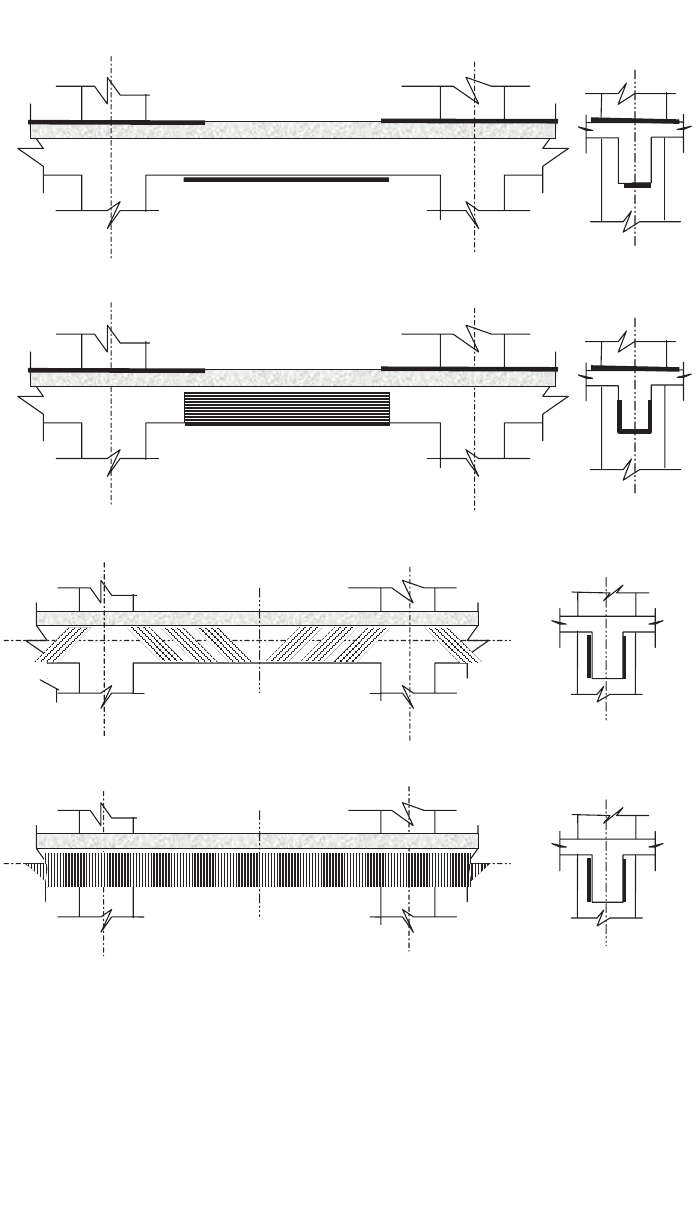
1372 COMPOSITES IN CONSTRUCTION
(a)
(b)
(c)
(d)
Fig. 3 Typical and the preferred FRP external flexural and shear: (a) Flexural reinforcement of
continuous RC floor beam using flat (0⬚)
n
laminates schedule; (b) Flexural reinforcement of con-
tinuous RC floor beam using the preferred U-shaped (0⬚)
n
laminates schedule; (c) Shear rein-
forcement of continuous RC floor beam using inclined laminated strips; (d ) Flexural
reinforcement of continuous RC floor beam using the preferred continuous flat (90⬚)
n
laminates
schedule.
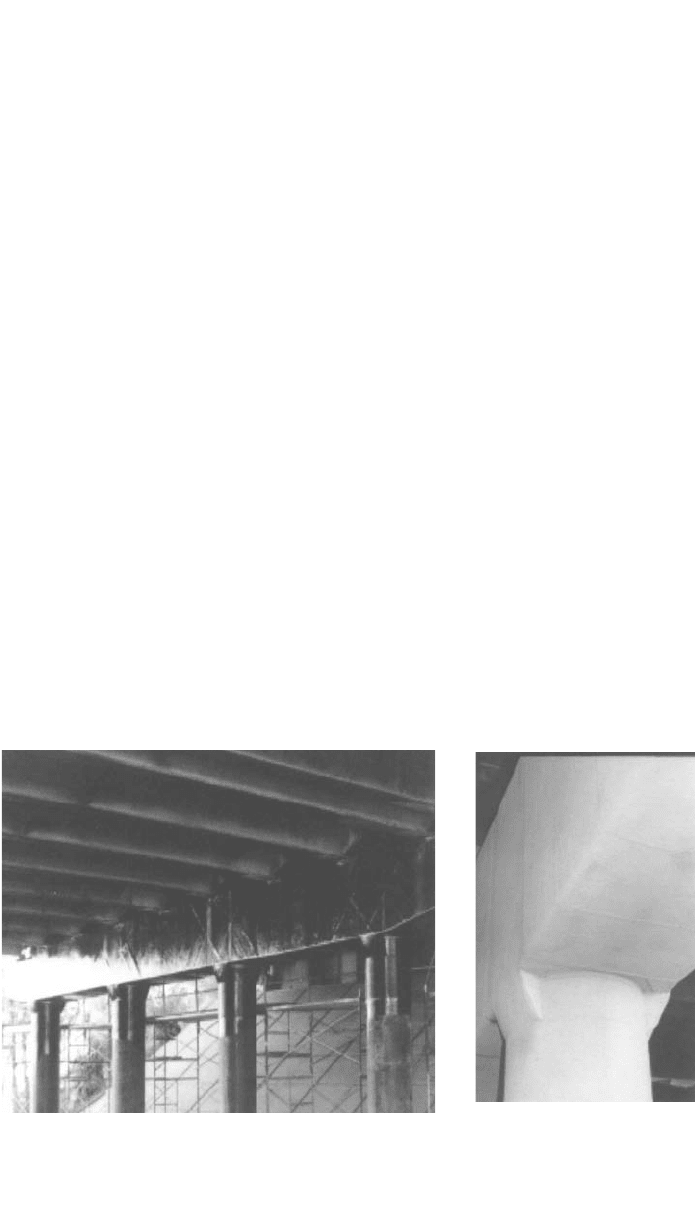
2 CONSTRUCTION APPLICATIONS OF COMPOSITES 1373
(a)(b)
Fig. 4 (a) State Street Bridge bent in Salt Lake City after being seismically retrofitted with
CFRP composites. (b) Detail of column-bent cap joint retrofitted with CFRP composites.
(Courtesy Professor C. Pantelides, University of Utah)
are exposed to tension due to the Poisson effect, which, in turn, provide the
required hoop stresses without adding to the column’s stiffness (i.e., stiffness/
strength decoupling). This application has been extended to cover other rein-
forced concrete structural members, such as beams (flexure, shear, and torsion
as shown in Fig. 3), slabs, beam–column joints, and walls. Figure 4a shows a
photograph of the U.S. Interstate 80 bridge over State Street in Salt Lake City,
Utah, that was seismically retrofitted with polymer composites. The bridge con-
sists of four reinforced concrete bents, each bent having four columns, and a
bent cap supporting composite welded girders is shown in Fig. 4b. A seismic
retrofit design was developed using carbon fiber-reinforced polymer (CFRP)
composites (Pantelides et al., 2001a) to improve the displacement ductility of
the bridge. The retrofit included column jacketing, as well as wrapping of the
bent cap and bent cap–column joints for confinement, flexural strength, and
shear strength increase. Special provisions were developed for the specifications
of the CFRP composite retrofit of State Street Bridge (Pantelides et al., 2001b).
The CFRP composite retrofit was implemented in the period 2000–2001.
Some of the potential repair and retrofit applications are:
1. Strengthening of reinforced concrete columns (refer to Figs. 1 and 2,
beams (Fig. 5), floor and bridge deck slabs (Fig. 6), and frame connec-
tions (Fig. 7)
2. Strengthening of concrete and steel fluid tanks (refer to Fig. 8)
3. Strengthening of stacks or chimneys (Fig. 9)
4. Reinforced concrete shear walls (Fig. 10)
5. Strengthening of slabs-on-grade (Fig. 11)
6. Strengthening of concrete, and steel pipes (Figs. 12 and 13)
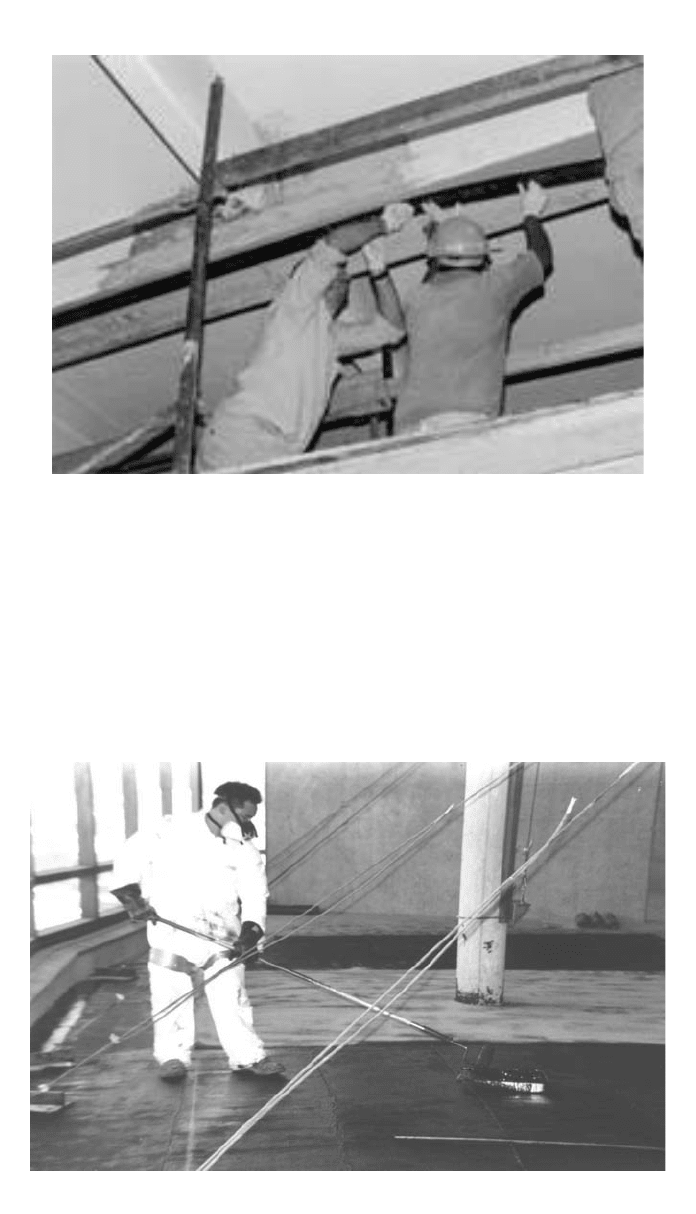
1374 COMPOSITES IN CONSTRUCTION
Fig. 5 Reinforced concrete beam strengthening applications using precured composite strips.
[Courtesy of Structural Composites Construction Inc. (SCCI)]
Fig. 6 Reinforced concrete floor slab strengthening applications using composites.
[Courtesy of Structural Composites Construction Inc. (SCCI)]
7. Strengthening of utility wooden poles (Fig. 14)
8. Strengthening of wooden beams and columns and plywood shear walls
(Fig. 15)
9. Strengthening of reinforced and unreinforced masonry walls (Fig. 16)

2 CONSTRUCTION APPLICATIONS OF COMPOSITES 1375
(b)
(a)
Fig. 7 Reinforced concrete beam-column connection repair applications using composites.
(a) California State University at Fullerton, and (b) McMaster University, Canada
(Ghobarah and Said, 2001).
10. Strengthening of tunnels (Fig. 17)
11. Strengthening of concrete members for explosion resistance (Fig. 18)
Types of Composite Repair Systems
Currently, the composite repair methods/systems that are available, include:
Wet/Hand Lay-up. In this method, the fibers are in the form of either uni-
directional or multidirectional sheets, waived, or stitched fabrics. After surface
pretreatment of the structural member, and the application of a thin film of low-
viscosity epoxy-based primary, the saturated fibers are applied by hand to the
location indicated in the engineering drawings (Fig. 19). The preferred method
of saturating the fibers is using custom-designed impregnator (or saturator) to
ensure proper and complete fiber impregnation with the resin system (Fig. 20).
However, some systems use brush and rollers to wet their fiber materials. The
common type of matrix used in wet layup repair application is room temperature
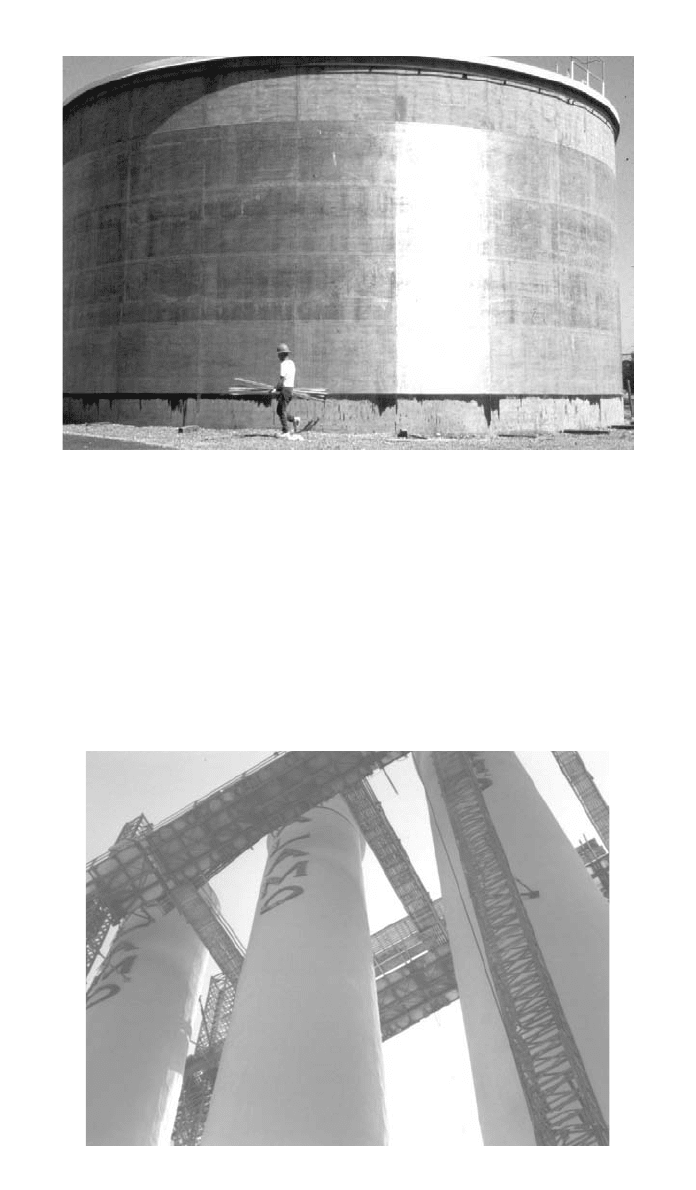
1376 COMPOSITES IN CONSTRUCTION
Fig. 8 Confinement of reinforced concrete tank using polymer composites.
(Courtesy of Fyfe Co. LLC)
Fig. 9 Structural strengthening of chimneys using polymer composites.
(Courtesy of Fyfe Co. LLC)
cure two-part epoxy systems. Several types of fibers are being used in this
process including standard and high-modulus carbon fibers, glass fibers (includ-
ing types E, S, and AR). A very limited commercial products uses aramid due
to its sensitivity to wet environment that is unavoidable in construction appli-
cations. However, it should be noted that aramid-based composites can also be
used in this application, provided that the fibers are completely protected from
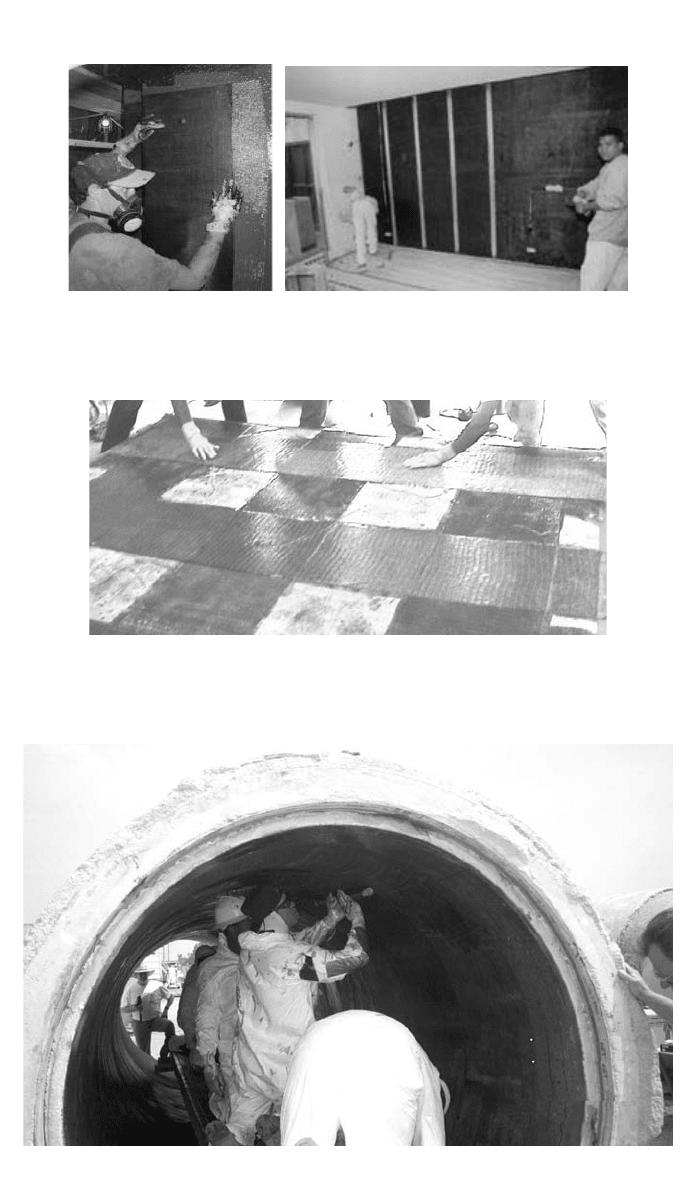
2 CONSTRUCTION APPLICATIONS OF COMPOSITES 1377
Fig. 10 Applications of composites for strengthening reinforced concrete shear walls.
[Courtesy of Structural Composites Construction Inc. (SCCI)]
Fig. 11 Structural strengthening of unreinforced concrete slab-on-grade using polymer com-
posites. [Courtesy of Structural Composites Construction Inc. (SCCI)]
Fig. 12 Strengthening of reinforced concrete pipes using polymer composites.
[Courtesy of Structural Composites Construction Inc. (SCCI)]
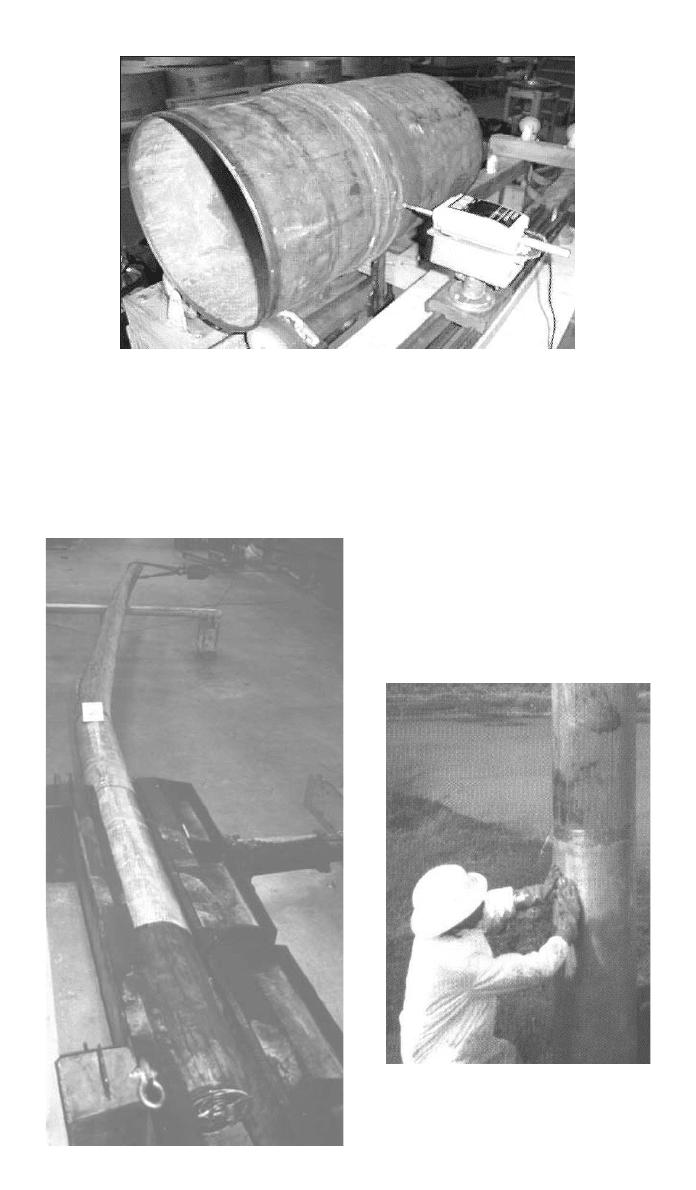
1378 COMPOSITES IN CONSTRUCTION
Fig. 13 Seismic strengthening of steel pipe joints using polymer composites.
[Courtesy of Professor O’Rourke, Cornell University (Tutuncu, 2001)]
Fig. 14 Structural strengthening of utility wooden poles using polymer composites.
(Courtesy of Fyfe Co. LLC)

2 CONSTRUCTION APPLICATIONS OF COMPOSITES 1379
Fig. 15 Structural strengthening of glue-lam wooden beams using carbon/epoxy
sandwich composites. (Courtesy of Sigma Composites, LLC)
Fig. 16 Strengthening of unreinforced masonry walls using polymer composites.
(Courtesy of Fyfe Co. LLC)
the surrounding environment particularly from moisture. Other FRP composites
repair systems made of hybrid materials have been used in a number of appli-
cations, especially when carbon-based composites are used around metallic parts.
In this case, a thin film or a thin mat of E-glass is used to avoid the development
of the corrosion process due to the galvanic action created when carbon-based
composites are in direct contact with metallic parts in the presence of an elec-
trolyte, such as water, that activates the galvanic process.
Table 1 presents average mechanical and physical values for common fibers
for composites used in construction repair applications as compared to steel. The
laminate properties are always lower than the dry fiber properties due to the
presence of the matrix, which has negligible structural capacity. In addition, if
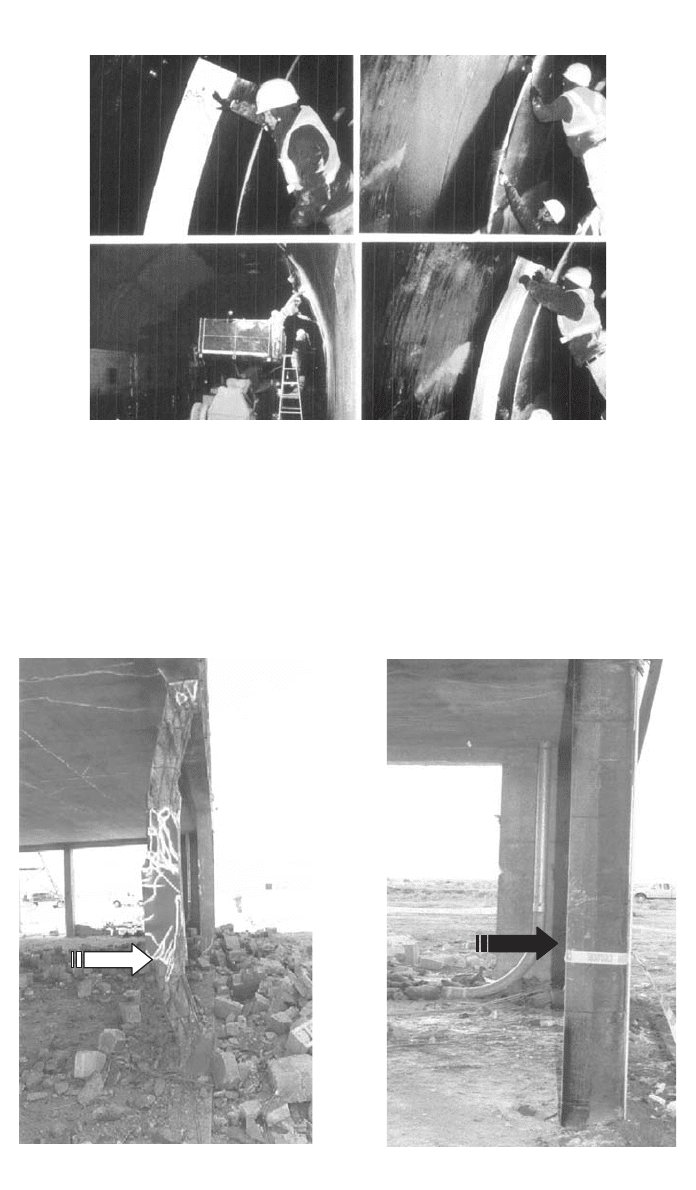
1380 COMPOSITES IN CONSTRUCTION
Fig. 17 Strengthening of tunnels using polymer composites. (Courtesy of TONEN Corp.)
Without
Composite
Jacket
With
Composite
Jacket
Fig. 18 Blast-resistance enhancement of reinforced concrete structures.
[Courtesy of Structural Composites Construction Inc. (SCCI)]
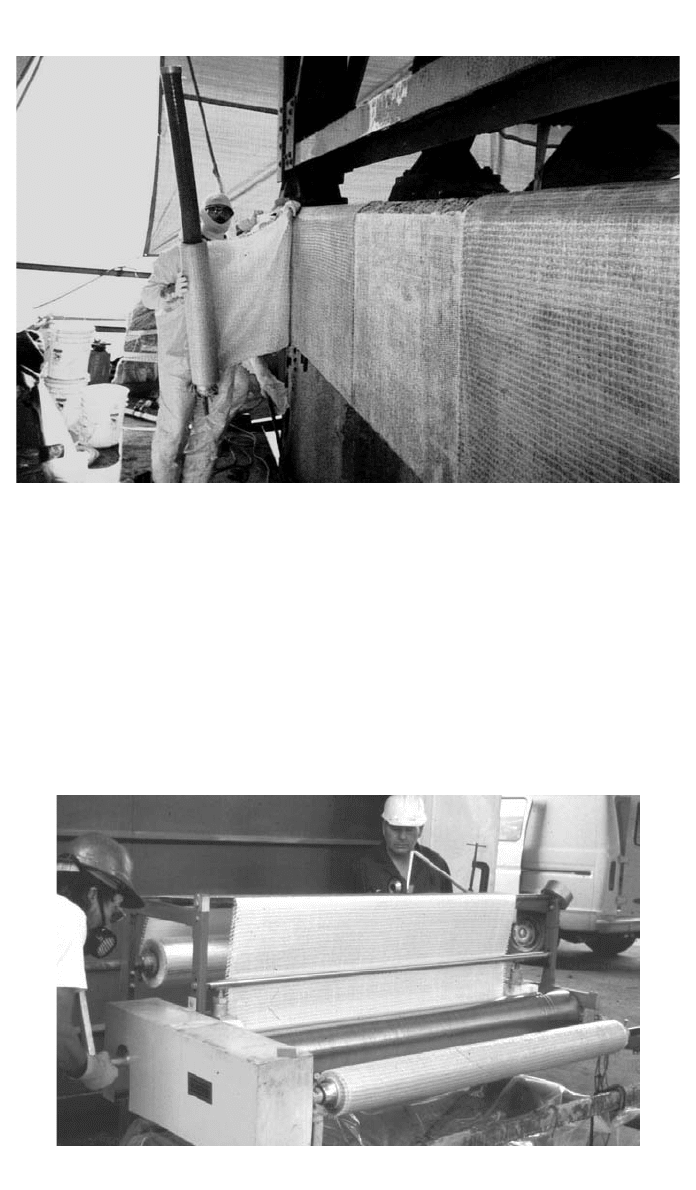
2 CONSTRUCTION APPLICATIONS OF COMPOSITES 1381
Fig. 19 Wet / hand lay-up repair process. (Courtesy of Fyfe Co. LLC)
Fig. 20 Use of automated saturators is the preferred method for wet lay-up repair process.
(Courtesy of Fyfe Co. LLC)
the fibers are directed in different directions (off-axis), the uniaxial or properties
parallel to the direction is expected to decrease depending upon the plies angles
and the volume of fibers in each direction relative to the major fiber direction
(on-axis) as shown in Fig. 21. This issue is very important and should be very
clear for the civil engineer who is unfamiliar with composites. The structural
engineer must distinguish between the fibers and laminate properties when de-
signing a repair system. The most critical information that is used in the design
